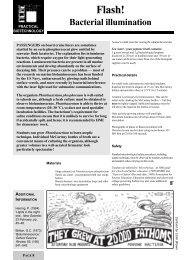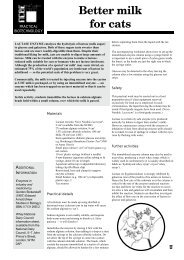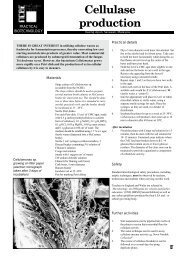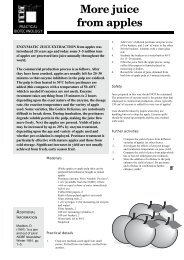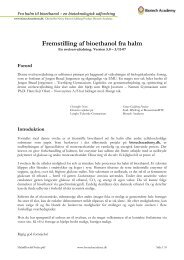Poplar tissue culture - National Centre for Biotechnology Education
Poplar tissue culture - National Centre for Biotechnology Education
Poplar tissue culture - National Centre for Biotechnology Education
Create successful ePaper yourself
Turn your PDF publications into a flip-book with our unique Google optimized e-Paper software.
PRACTICAL<br />
BIOTECHNOLOGY<br />
<strong>Poplar</strong><br />
<strong>tissue</strong> <strong>culture</strong><br />
PLANT TISSUE CULTURE experiments in school are often a<br />
problem: either the plant <strong>tissue</strong> is insufficiently sterilized, or <strong>for</strong> some<br />
reason the <strong>tissue</strong> just refuses to grow. This is compounded by the high<br />
cost of both the <strong>tissue</strong> <strong>culture</strong> medium and plant growth substances,<br />
and the inordinate length of time it takes to prepare everything. Here’s<br />
a practical which overcomes all of these difficulties. It requires neither<br />
aseptic conditions or expensive growth media.<br />
Materials<br />
Freshly-sprouted twigs from poplar trees<br />
(Populus sp.)<br />
Aqueous solution of kinetin, about 1 cm 3<br />
Make up a concentrated stock solution of kinetin<br />
in distilled water, then dilute this further to<br />
obtain 0.002 g per litre. Kinetin does not<br />
dissolve readily in water unless the solution is<br />
made alkaline using, <strong>for</strong> example, a few pellets<br />
of sodium hydroxide.<br />
9 cm diameter discs of Whatman No.1<br />
filter paper, 2–3<br />
Clean Petri dish<br />
Adhesive tape or Parafilm<br />
Sharp knife or scalpel<br />
Petri dish and wet them thoroughly with the<br />
kinetin solution.<br />
3. Place the twigs, cut surface uppermost, on the<br />
filter paper.<br />
4. Replace the Petri dish lid and secure it well,<br />
but not over-zealously, around the rim with<br />
adhesive tape. The aim is to reduce<br />
evaporation of the kinetin solution, without<br />
making it difficult to remove the lid to replenish<br />
the solution at intervals as necessary.<br />
5. Keep the Petri dishes in a warm, well-lit place.<br />
Examine them at weekly intervals. After a few<br />
weeks callus <strong>tissue</strong> will <strong>for</strong>m. Buds may also<br />
grow shortly after this.<br />
6. If mould appears on the uppermost filter paper,<br />
just slip it out from under the twigs using<br />
<strong>for</strong>ceps, leaving the uncontaminated paper<br />
discs below.<br />
7. Should the filter paper begin to dry out, simply<br />
re-wet it with distilled water.<br />
Safety<br />
Plastic gloves should be worn whilst handling kinetin<br />
powder. Spills of kinetin should be washed up<br />
promptly, using plenty of water.<br />
Practical details<br />
Further activities<br />
1. Cut internodal lengths of poplar twigs about 1–2<br />
cm long, and split them lengthwise using a sharp<br />
knife or scalpel.<br />
2. Put 2–3 filter paper discs into the base of the<br />
Students could investigate the effect of light, the<br />
concentration of kinetin, interaction with other plant<br />
growth substances (such as IAA) or the use of<br />
different plant species.<br />
ADDITIONAL<br />
INFORMATION<br />
This investigation<br />
was suggested in<br />
Experiments in plant<br />
<strong>tissue</strong> <strong>culture</strong><br />
(Second Edtn) by<br />
John Dodds and<br />
Lorin Roberts<br />
(1985) Cambridge<br />
University Press.<br />
ISBN: 0 521 31516 6.<br />
It has been adapted<br />
<strong>for</strong> schools use by<br />
John Schollar at the<br />
NCBE.
<strong>Poplar</strong> <strong>tissue</strong> <strong>culture</strong><br />
1. Split the poplar twigs lengthways<br />
(a scalpel is more convenient than<br />
an axe <strong>for</strong> this task).<br />
2. Put two or three pieces of filter<br />
paper into a Petri dish and<br />
moisten them with<br />
kinetin solution.<br />
3. Place the split twigs (cut surface<br />
uppermost) onto the moistened<br />
paper.<br />
4. Seal the Petri dish<br />
lid loosely, with<br />
sticky tape.<br />
(Don’t fix the lid on too<br />
firmly, as you may wish<br />
to water the twigs from<br />
time to time.)<br />
5. Keep the Petri dish in a warm, light place.<br />
Cartoon by Colin Brown<br />
3 weeks later ... 6 weeks later ... 6 months later ...<br />
© <strong>National</strong> <strong>Centre</strong> <strong>for</strong> <strong>Biotechnology</strong> <strong>Education</strong>, 1995



